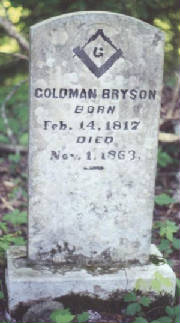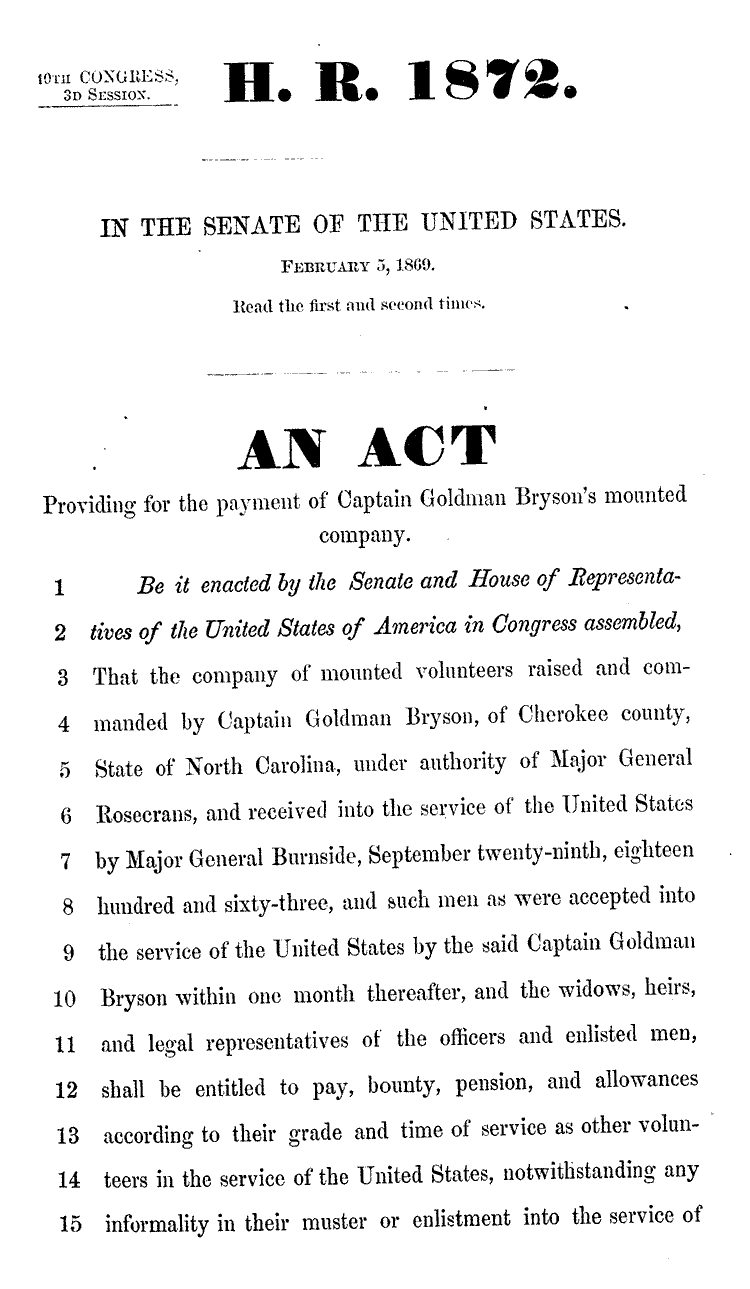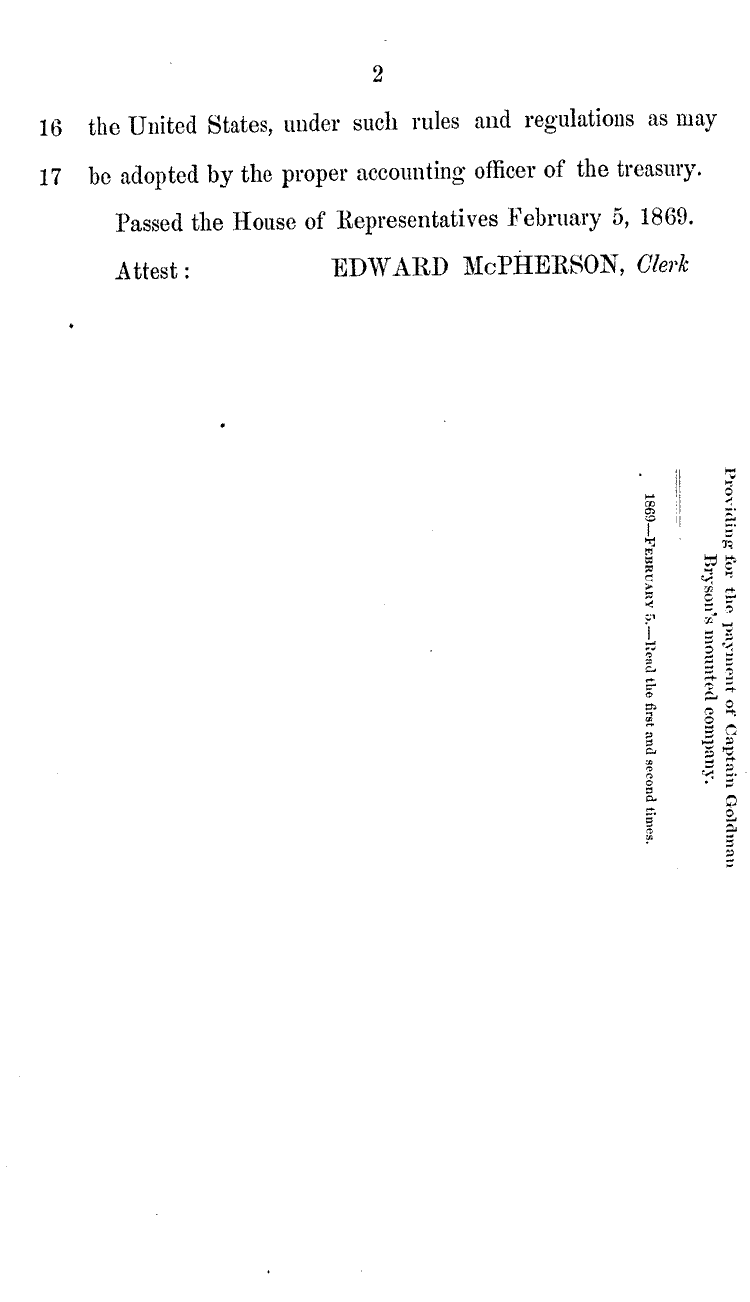|
Captain Goldman Bryson
Captain
Goldman Bryson's Federal Mounted Company
(See also photocopy of H.R. 1872 below)
Introduction
During the Civil War, Captain Goldman Bryson's Union Volunteers had
many names and designations, including Bryson's Federal Company of Raiders, The Bryson Gang, Union First Tennessee National
Guard, Bryson Gang of Western North Carolina, Bryson's Bushwhackers, and Bryson's East Tennessee Volunteers. The U.S.
Senate, however, would officially recognize the unit as Captain Goldman Bryson's Mounted Company.

|
| Captain Goldman Bryson |
History
Captain Goldman Bryson's Federal Mounted Company, or so-called “Mountain Robbers,” was an estimated force of 120-150 troops and during
the Civil War it raided numerous Western North Carolina communities. The unit warranted tremendous hatred for several
reasons. On August 31, 1856, Goldman Bryson was implicated in the murder of John Timson, a Cherokee constitutional
convention delegate that resided in Cherokee County. Goldman's brother and sister testified and provided Goldman's alibi and, because his accuser was a mixed-blood
Cherokee, the murder charge was dismissed. Cherokee intermarriage, with whites, was most characteristic along the
Valley River, near Murphy, Cherokee County. Although Goldman was acquitted of murder, many Cherokee County residents
viewed him as a murderer. Bryson was born in Haywood County, in Western
North Carolina, and during the Civil War he terrorized the very people, kindred, and communities that
once loved him, thus epitomizing the “brother killing brother” during the war. Goldman Bryson is related to Colonel
Thaddeus Bryson, one of the founders of Bryson City, in Western North Carolina (Bryson
City, through the years, had been referred to as Tuckoritchie, Tuckaleechy Town, Big Bear’s Reserve, and Charleston).
Hence, the Western Carolinians referred to Goldman as a “Home Yankee.” The ominous maelstrom awaiting the Bryson Troops
climaxed with its last raid on the town called Murphy, in familiar Cherokee County. Goldman and his tories entered
the city, arrogantly marched the streets, and then sacked the town. Now, the Cherokees, Western North Carolinians, General
Braxton Bragg, Governor Zebulon Vance, and Thomas’ Legion were steadfast in their determination to eradicate the Bryson
Gang and finally halt these egregious and deplorable acts.
Without stopping or eating, the Cherokees of Thomas’ Legion tracked the “gang” for two days. When
the Cherokees located Goldman Bryson, Lt. C. H. Taylor, a Cherokee, demanded Goldman Bryson to halt, he refused, and then Lt. Taylor shot him. Bryson ran
and was shot several more times. Next, the Cherokees wore Goldman's bloody clothes and proceeded through the streets
of Murphy. General Braxton Bragg and Governor Zebulon Vance publicly applauded and congratulated Thomas’ Legion for
exterminating “Goldman and his Robbers.” It was rare to be recommended by name to one
of the eight generals in the Confederate States Army, and Lt. Campbell H. Taylor received that honor when he
was commended to General Braxton Bragg. There were four general grades in the Confederate States Army: brigadier-general,
major-general, lieutenant-general, and general being the highest attainable rank. However, during informal communication each
may be addressed as general.
Report of Lieut. C.
H. Taylor: Thomas’ Legion C. S. Army.
Murphy, N.C.
November 1, 1863.
Sir: on October 27, General Vaughn, with a detachment of his mounted men, overtook Goldman Bryson, with his company of mounted robbers, in Cherokee
County, N.C., attacked him, killing 2 and capturing 17 men and 30 horses.
On
the 28th, I left Murphy with 19 men, taking Bryson’s trail through the mountains; followed him 25
miles, when I came upon him and fired on him, killing him and capturing 1 man with him. I found in his possession his orders
from General Burnside and his roll and other papers.
My men all acted nobly;
marched two days, and without anything to eat.
Yours, Respectfully,
C. H. Taylor
Lieutenant, Comdg,
Co. B, Infantry Regt., Thomas’ Legion
Lieutenant-Colonel
Walker
Commanding Battalion,
Thomas’ Legion
[Enclosure of General
Burnside’s papers found on Goldman Bryson]
Special Field Orders,
No. 56: HDQRS. Army of the Ohio: Knoxville, East Tenn., October, 22, 1863.
VI. Capt. G.
Bryson, First Tennessee National Guard, is hereby ordered to proceed with his command to North
Carolina and vicinity, for the purpose of recruiting, and will return here within a fortnight,
when he will report in person at these headquarters.
By order of Major-General
Burnside:
Edward M. Neill,
Major, and Assistant
Adjutant-General
General Bragg:
Permit me, general,
to recommend to your notice C. H. Taylor, lieutenant, who commanded the Indians at the killing of Captain Bryson. You will pardon me, general, in not sending this
through the proper channel, we have no mails.
W. C. Walker,
Lieutenant-Colonel,
Comdg. Battalion, Thomas’ Legion
O.R. 1, Volume 31, pt I, p. 235
Finally, years after the conflict, Goldman Bryson and Company receive official
recognition:
Bills and Resolutions, House of Representatives, 40th Congress, 3rd Session, Read the first and second times.
An Act Providing for the payment of Captain Goldman Bryson's mounted company.
February 5, 1869
Read the first and second times. An Act Providing for the payment of Captain Goldman
Bryson's mounted company.
(Below is a photocopy of the Bill providing payment to the Goldman Bryson Company's
veterans.)
(Continued below.)
Recommended Reading: Bushwhackers, The
Civil War in North Carolina: The Mountains
(338 pages). Description: Trotter's book (which could
have been titled "Murder, Mayhem, and Mountain Madness") is an epic backdrop for the most horrific murdering, plundering
and pillaging of the mountain communities of western North Carolina during the state’s darkest hour—the American
Civil War. Commonly referred to as Southern Appalachia, the North Carolina and East Tennessee mountains witnessed divided loyalties in its bushwhackers and guerrilla units. These
so-called “bushwhackers” even used the conflict to settle old feuds and scores, which, in some cases, continued
well after the war ended. Continued below...
Some bushwhackers
were highly organized ‘fighting guerrilla units’ while others were a motley group of deserters and outliers,
and, since most of them were residents of the region, they were familiar with the terrain and made for a “very formidable
foe.” In this work, Trotter does a great job on covering the many facets of the bushwhackers, including their: battles,
skirmishes, raids, activities, motives, the outcome, and even the aftermath. This book is also a great source for tracing
ancestors during the Civil War; a must have for the family researcher of Southern Appalachia.
Recommended Reading: The Loyal Mountaineers Of Tennessee (1888) (Hardcover) (426 pages)
(Kessinger Publishing, LLC) (June 2, 2008). Description: This book defines the importance of East Tennessee
and its residents to the Union cause during the Civil War. The author begins with early history of East
Tennessee and the events which led to the War Between the States. He continues by describing local people and
events that contributed to the decision to remain loyal to the United States.
The events of the War as they involve East Tennessee are detailed, including important meetings and battles such as Carter's
Raid and the siege of Knoxville. Continued below...
The text is enhanced with illustrated portraits of East Tennessee individuals who
contributed to the Civil War effort. Originally written and published in 1888, this reprinted edition is accompanied by a
complete index. This book is a valuable addition to both the Tennessee
historian and the Civil War buff.
Recommended Reading: Mountain Rebels: East
Tennessee Confederates and the Civil War, 1860-1870 (240 pages) (University of Tennessee Press). Description:
In this fine study, Groce points out that the Confederates in East Tennessee suffered more for the ‘Southern Cause’
than did most other southerners. From the first rumblings of secession to the redemption of Tennessee in 1870, Groce introduces
his readers to numerous men and women from this region who gave their all for Southern Independence. Continued below...
He also points out that East Tennesseans were divided in their loyalties and that slavery played only a
small role. Groce goes to great lengths to expose the vile treatment of the Region’s defeated Confederates during the
Reconstruction. Numerous maps, pictures, and tables underscore the research.


Sources: Official Records of the Union
and Confederate Armies; Vernon H. Crow, Storm in the Mountains: Thomas' Confederate Legion of Cherokee Indians and Mountaineers;
Vernon H. Crow, The Justness of Our Cause; Walter Clark, Histories of the Several Regiments and Battalions from North Carolina
in the Great War 1861-1865; Weymouth T. Jordan and Louis H. Manarin, North Carolina Troops, 1861-1865; E. Stanly Godbolt,
Jr. and Mattie U. Russell, Confederate Colonel and Cherokee Chief: The Life of William Holland Thomas; The Civil War Diary
of William W. Stringfield, Johnson City, TN: East Tennessee Historical Society Publications; John H. Stewart Papers (Private
Collection); The Thomas Legion Papers (thomaslegion.net/papers.html); D. H. Hill, Confederate Military History Of North Carolina: North Carolina In The Civil War, 1861-1865; and Library
of Congress.
|

